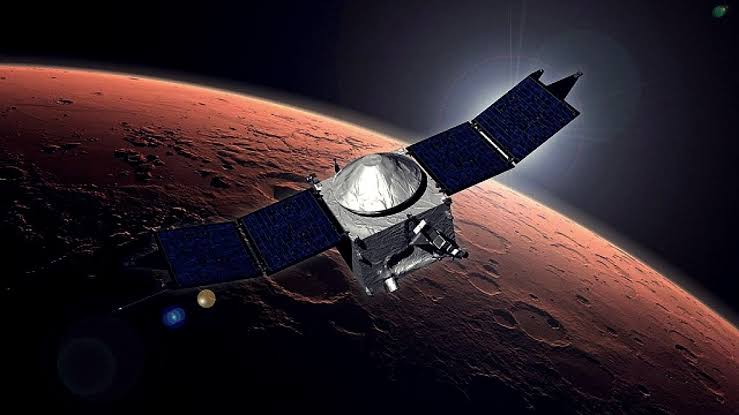Mangalyaan was a great Scientific Mission to planet Mangal

When India’s Mangal Orbiter Mission (MOM) spacecraft successfully entered planet Mangal’s orbit on September 23, 2014, it made the Indian Space Research Organisation the fourth organisation in the world to achieve the feat, after NASA, the space agency of the erstwhile Soviet Union and the European Space Agency (ESA).
However the feather in the cap was that while USA achieved its success in the second attempt and Russia in 8th attempt, ISRO did it in the first attempt. A second very important thing was ‘Mangalyaan’ India’s first interplanetary space vehicle cost just Rs 525 Crores. This earned it even more international applause from Asian, African and South American countries, as it showed that space exploration was a doable thing for other countries too.
A third factor which riles NASA and European Space Agencies is that ISRO officially described the Mangalyaan spacecraft’s end of life on 03 October 22 press release without giving out any technical details. Thus despite being designed for a life-span of just six months as a technology demonstrator, the Mangal Orbiter Mission has lived for about eight years in the Mangal orbit with a gamut of significant scientific results on Mangal as well as on the Solar corona, before losing communication with the ground station, as a result of a long eclipse in April 2022.
ISRO said that the propellant must have been exhausted, and therefore, the desired altitude positioning could not be achieved for sustained power generation. It was declared that the spacecraft was non-recoverable, and attained its end-of-life. The mission would be ever-regarded as a remarkable technological and scientific feat in the history of planetary exploration.
Now what agitates the NASA and others is that ISRO never officially communicated any efforts or technical details to keep the spacecraft alive, which they were eagerly waiting, as it would give them load of data to study and find out how ISRO achieves such super results. Same was the clamour made when India had exploded both nuclear and thermonuclear devices at Pokhran in 1998. A few even went to the extent of declaring it as fake or a failed test.
The same was the case, when Pentagon was shocked by a MiG 21 Bison downing a F16 and a dozen or so AARM missile fired by F16s failed to reach their targets. Every joker in the Pack wanted proof from IAF, it’s silence infuriated every one to tell hilt.
Western Agencies are quite sad that ISRO a publicly funded agency has hidden all details. As if NASA and others give out all the details on daily basis.
Then every one is very angry ( no wonder that Cartoon in one of those crap paper after success of Mangalyaan ) about ISRO calling Mangalyaan a “scientific” success. The continuous barb is that Mangalyaan produced no scientific results….. but Who cares in India ….mirchi laagi to main kya kaaru. Even the name Mangalyaan must be galling them.
NASA is not happy at all regarding the ‘ lethargic ‘ attitude of ISRo Scientists as they have produced only 27 papers relating to Mangalyaan, even after six years of the craft being in orbit. In contrast, they gloat about their MAVEN which helped them to churn out many “seminal” scientific results about the Mangal’s atmosphere, with a repository of at least 500 papers and growing.
What’s more concerning about Mangalyaan’s short publications list is that about half of those are simply engineering descriptions of the mission, not scientific results from the mission. NASA probably dreads another sudden coup by ISRO from the hidden scientific materials.
Well NASA seems to be rather very happy regarding failure of the methane sensor on the Mangalyaan. The instrument was to globally map methane with a sensitivity of parts per billion, to help decide if the methane on Mars could be a sign of subsurface life. But two years after launch, the instrument was found to have a design flaw and so it can’t detect methane at all. ……or is that Indians have quietly gathered all the data for use in future.
The NASA apprehension though may not be unfounded. As S.M. Ahmed, a former member of Chandrayaan-1’s Moon Impact Probe and then the principal scientific officer at the Central Instrumentation Facility, University of Hyderabad, and Anindya Sarkar, a professor of geology and head of the National Mass Spectrometry facility at IIT Kharagpur, have contested MAVEN achievements as touted by NASA versus achievements of Mangalyaan.
One chap batting for NASA writes : For every ISRO mission, the trajectory is known first, before the payload. In other words, ISRO knew the path that MOM would take from Prithvi to Mangal and then the shape of its orbit around Mangal before finalising the instruments that would be onboard MOM. Yet many of the instruments were not designed for the elliptical orbit that MOM operated in, limiting the value of their scientific output. “ However he does not clarify that why did NASA first mission fail, they too knew everything !!!
Now grapes are sour, so NASA apologists gloat that Mangalyaan’s scientific output is low because it was never designed to be a scientific mission. For them Mangalyaan was a just a technology demonstrator, right from making things work with an unusually small launch vehicle to the planetary exploration technologies it helped develop for India. Keep gloating they should and wait for a new surprise !!
What is hilarious is that they are agitated and accusing India for “ forcibly” calling the Mangal Mission a Scientific Mission. They feel it is not only something more is not just wrong but dangerous….. for whom has not been clarified.
Some are even trying to cajole ISRO to publish at least more scientific papers comparable with endeavours undertaken for Chandrayaan 1 or AstroSat, each of which have led to hundreds of published works in international journals. The emphasis is on the ongoing Chandrayaan 2 orbiter, with specific papers – such as quantifying water on the Chandrama’s poles and the sunlit surface.
Another example demonstrating the orbiter’s raw capacity published in an international journal that concerns the amount of plasma in Cchandrama’sc exosphere. This is a key characterising measurement never undertaken by any prior spacecraft. ISRO shared another similarly vetted and unique result on the agency’s website on October 7, about the first global-scale sodium maps of Chandrama.
So international community is sad, anguished and terribly angry at the same time that ISRO is giving out a steady stream of quality results on Chandrama but sadly, simply never on Mangalyaan.
Time to surprise everyone with a Shukrayaan and another Mangalyaan.




